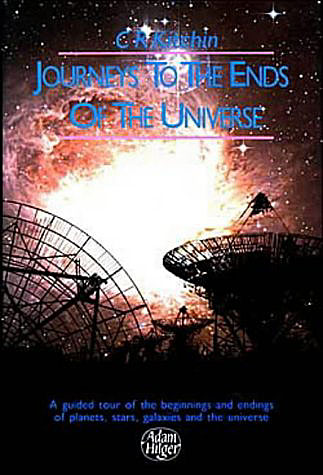

| JOURNEYS TO THE ENDS OF THE UNIVERSE C. R. Kitchin Bristol, UK: Adam Hilger, 1990 |
Rating: 5.0 High |
|||
| ISBN-13 978-0-7503-0037-7 | ||||
| ISBN 0-7503-0037-X | 198pp. | HC/BWI | $38.00 | |
We are living through a breathtaking expansion of cosmological knowledge. Less than a century ago, Edwin Hubble identified the Milky Way as one of a multitude of galaxies dwindling into immense darkness and isolation, and discovered that these galaxies are moving apart. The existence of quasars, pulsars, black holes, planets around other stars,1 the Big Bang itself, were all accepted well after the births of the majority of living Americans. Continuing improvements in telescopes and other instruments, along with the fact that mystery still lies at the heart of both physics and cosmology, promise us more surprises in the near future.
The public is hungry to learn about such developments, and a host of popular books has been written to tap this well of public interest. Many have essayed a "grand tour of the cosmos" approach. C. R. Kitchin, of the Hatfield Polytechnic Observatory, follows this model; but he has written a more technical treatment. While it contains no equations, it reads much like an astrophysics textbook. A host of exotic denizens of the cosmos — Bok globules, Herbig-Haro objects, Jeans masses, Seyfert galaxies, Wolf-Rayet stars — abide in its pages.2 In addition there are plots of observations of e.g. the microwave background remnant from the Big Bang, stellar spectra, or solar neutrino energies, as well as diagrams such as those showing the large-scale structure of the universe, or the reactions that power the sun: the proton-proton chain and the CNO cycle.3
I found this material fascinating, but it was heavy going in places. In my opinion, Kitchin's book would have benefited from collaboration with a professional writer — not to dumb it down, but to tighten up awkward passages, provide clearer "signposts" for the journeys, define terms when they are first introduced, and fix grammatical errors. (There are only a few of the latter.) One other thing that puzzled me is that some of the many astronomical photographs are printed as negatives. Doubtless there are excellent reasons for doing this, but Kitchin does not reveal it.
The book contains a bibliography and an index. The bibliography lists 44 books, and each is cross-referenced to the journeys to which it is relevant. The index is brief and omits names of individuals mentioned in the text (e.g. Johannes Kepler, William Herschel, Edwin Hubble, André Linde, George Gamow), but it does include the technical terms. It also highlights the page numbers that refer to lengthy treatments of their topics. To sum up, I would not recommend this book to someone new to cosmology. There are many popular treatments more suitable for such readers. But if you're looking for something about halfway between these and a true astrophysics textbook, Journeys to the Ends of the Universe is a good candidate.

 To contact Chris Winter, send email to this address.
To contact Chris Winter, send email to this address.